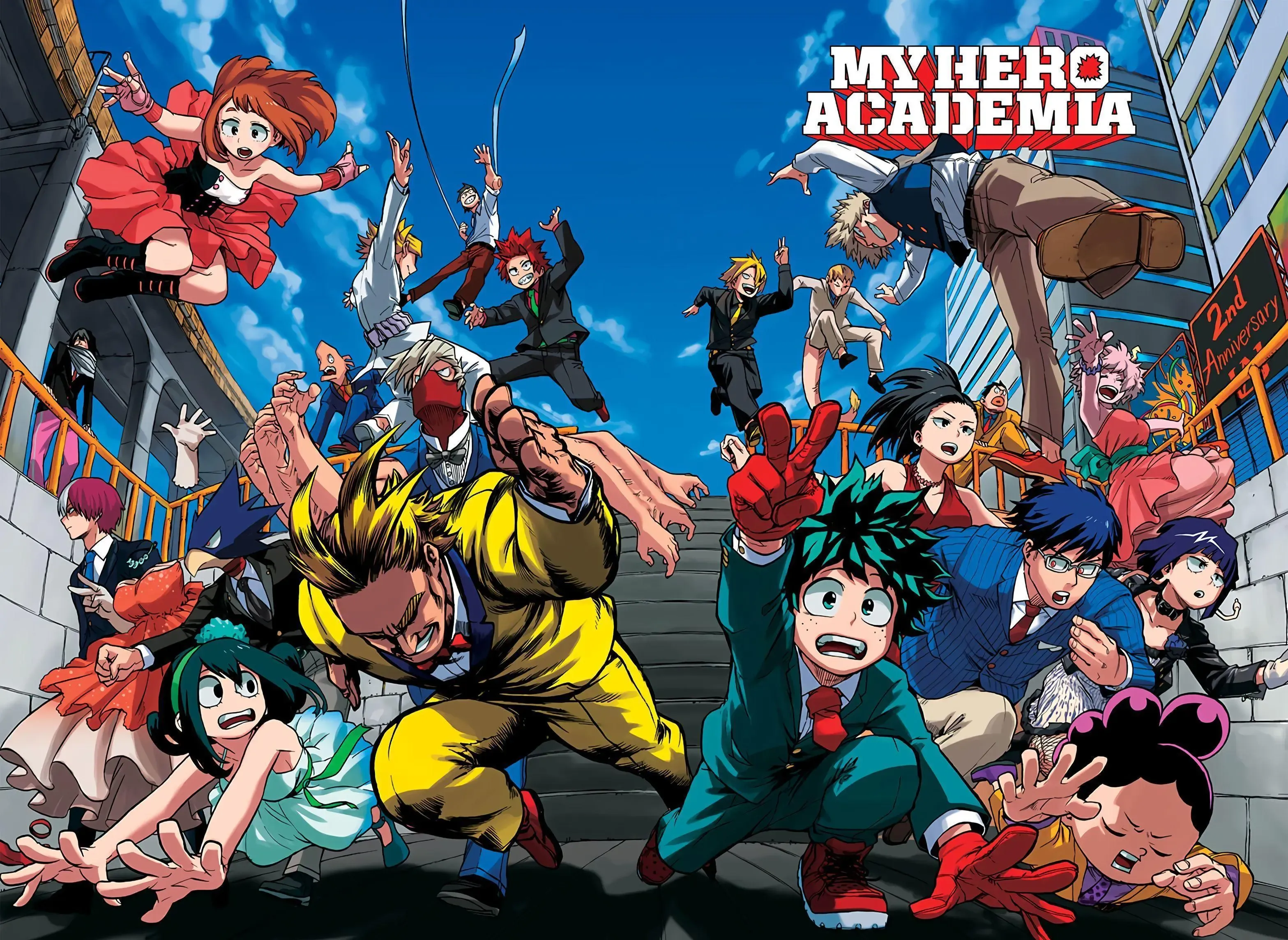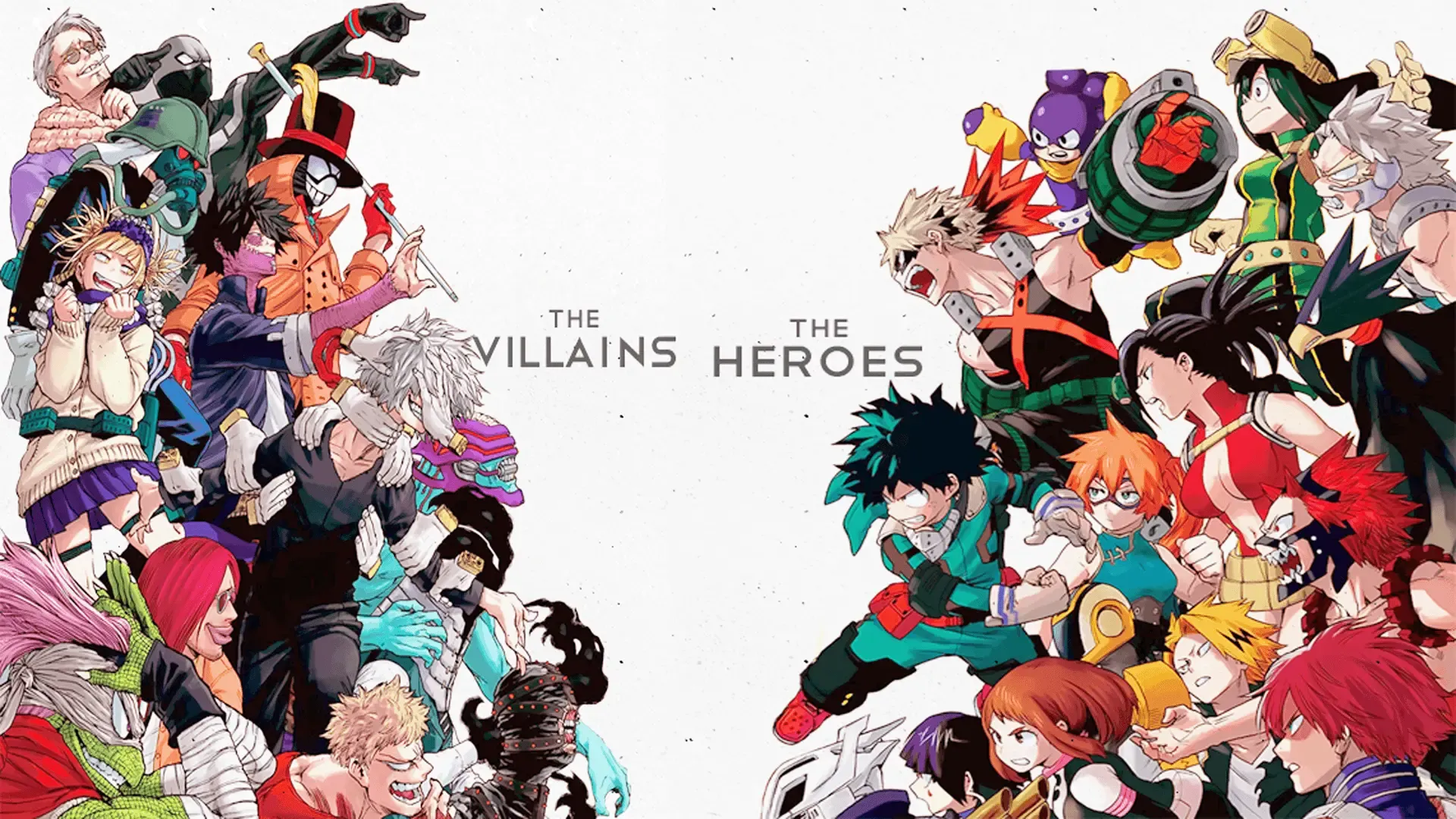
My Hero Academia: (Boku no Hero Akademia)
My Hero Academia, also known as Boku no Hīrō Akademia in Japan, is a popular manga and anime series that has gained immense popularity globally. The story revolves around a young boy named Izuku Midoriya who dreams of becoming a hero despite being born without a Quirk (superpower), in a world where almost everyone has a Quirk. The series explores the journey of Izuku Midoriya as he trains to become a hero at the prestigious U.A. High School, and eventually, the greatest hero of all time.
The World of My Hero Academia
My Hero Academia takes place in a world where almost everyone has a unique and powerful ability known as a Quirk. The presence of these Quirks has changed the world and how it functions, leading to the rise of professional heroes who use their powers to protect and serve the public.
In this world, having a Quirk is seen as a blessing and a way for people to contribute to society. However, not everyone has the ability to use their Quirk for good, and there are those who choose to use their powers for evil. This has resulted in the need for professional heroes to step up and fight against these villains.
The world of My Hero Academia is highly advanced, with technology being developed to support the heroes and keep the public safe. There are hero agencies that provide training, support, and resources to help individuals become professional heroes.
One of the most prominent hero agencies is U.A. High School, where the protagonist, Izuku Midoriya, trains to become a hero. This school is highly respected and produces some of the best heroes in the world.
In this world, heroes are not just respected, but they are also idolized by the public. People look up to them as symbols of hope and inspiration. The heroes of My Hero Academia work tirelessly to uphold justice and protect the people, making it a thrilling and dynamic world to explore.
Read The Manga
The Characters of My Hero Academia

My Hero Academia boasts a large cast of well-developed and memorable characters, each with their unique personalities, backgrounds, and abilities. Let's take a closer look at some of the most important characters in the series:
- Izuku Midoriya: The main protagonist who dreams of becoming a hero despite being born without a Quirk.
- All Might: The world's greatest hero and symbol of peace, with a powerful Quirk allowing him to transform.
- Katsuki Bakugo: Izuku's classmate, confident, aggressive, and highly competitive with a strong sense of justice.
- Ochaco Uraraka: Another classmate with a cheerful personality and the ability to manipulate gravity.
- Shoto Todoroki: A classmate with a troubled past and a complicated relationship with his father, possessing ice and fire powers.
- Tenya Iida: The class president with super speed and a strong sense of duty and justice.
- Tsuyu Asui: A classmate with a frog-like appearance and the ability to do anything a frog can.
- Eijiro Kirishima: A classmate with the ability to harden his body like rock, known for his strong sense of friendship and loyalty.
- Momo Yaoyorozu: A classmate with the ability to create objects from her body, known for her intelligence and leadership skills.
- Denki Kaminari: A classmate with the ability to generate electricity, often seen as carefree and fun-loving.
- Fumikage Tokoyami: A classmate with a bird-like appearance and the ability to control a shadowy creature called Dark Shadow.
- Kyoka Jiro: A classmate with the ability to turn her earlobes into earphone jacks, often seen with a cool and composed demeanor.
- Minoru Mineta: A classmate with sticky ball-like hair and the ability to produce sticky balls from his head.
- Mezo Shoji: A classmate with multiple arms and the ability to stretch them at will.
- Hanta Sero: A classmate with tape-like appendages he can shoot from his elbows.
- Koji Koda: A classmate with a timid personality and the ability to communicate with animals.
- Rikido Sato: A classmate with enhanced strength that increases with sugar intake.
- Toru Hagakure: A classmate who is invisible, often underestimated but possesses great potential.
- Mashirao Ojiro: A classmate with a tail that gives him enhanced agility and balance.
- Yuga Aoyama: A classmate with the ability to shoot laser beams from his belly button.
- Mina Ashido: A classmate with pink skin and the ability to excrete acid from her body.
- Tooru Hagakure: A classmate who is invisible, often underestimated but possesses great potential.
- Neito Monoma: A student from Class 1-B with the ability to copy others' Quirks temporarily.
- Itsuka Kendo: The class president of Class 1-B with the ability to enlarge and strengthen her fists.
- Juzo Honenuki: A student from Class 1-B with the ability to manipulate mud.
- Pony Tsunotori: A student from Class 1-B with a horse-like appearance and the ability to shoot her horns as projectiles.
- Sen Kaibara: A student from Class 1-B with spiral-shaped hair and the ability to spin his body at high speeds.
- Kinoko Komori: A student from Class 1-B with mushroom-like hair and the ability to grow mushrooms from her body.
- Tetsutetsu Tetsutetsu: A student from Class 1-B with a Quirk similar to Eijiro Kirishima's, allowing him to harden his body like steel.
- Setsuna Tokage: A student from Class 1-B with the ability to detach and control her body parts independently.
Buy Merchandising
The Publishing Process
My Hero Academia is a Japanese manga series written and illustrated by Kōhei Horikoshi. The series has been serialized in Weekly Shonen Jump magazine since July 2014 and has been compiled into 27 tankōbon volumes as of February 2023. The manga has become one of the most popular in Japan and around the world, leading to its publication in many languages.
The publication process of My Hero Academia starts with Horikoshi submitting his manga chapters to Weekly Shonen Jump magazine. The magazine’s editors read the chapters and provide feedback and suggestions for improvement. Horikoshi then makes the necessary revisions and resubmits the chapters for approval. Once the chapters are approved, they are printed in the magazine and serialized for the readers.
After the chapters have been serialized in the magazine, they are collected into tankōbon volumes and published by Shueisha. These volumes contain multiple chapters of the manga and are sold in bookstores and online. The tankōbon volumes provide fans with a way to read the manga in its entirety and to collect the series.
In addition to the tankōbon volumes, My Hero Academia has also been adapted into an anime series, which has been well received by fans. The anime adaptation provides a visual representation of the manga’s world and characters and has increased the popularity of the series even further.
The publishing process of My Hero Academia is a collaborative effort between Horikoshi, the editors at Weekly Shonen Jump, and Shueisha. It requires a great deal of effort and attention to detail to ensure that the manga is of the highest quality and is accessible to fans around the world.
The Anime Seasons

The anime adaptation of My Hero Academia has been a huge success, with fans eagerly anticipating each new season. The series has been produced by the animation studio Bones and has been airing since 2016. The anime has followed the manga closely, adapting the story and characters for the screen.
As of February 2023, there have been five seasons of the My Hero Academia anime, with a sixth season currently in production. Each season has consisted of multiple episodes, with the first season having 13 episodes, and each subsequent season having 25 episodes.
The first season of the My Hero Academia anime introduces viewers to the world of the manga and its characters. It follows the story of Izuku Midoriya, a young boy who dreams of becoming a hero despite not having a Quirk, or a special power. The season also introduces viewers to U.A. High School, a prestigious school for aspiring heroes, and its students and teachers.
The second season of the anime builds on the foundation established in the first season and introduces new characters and plotlines. It explores the relationships between the characters and delves deeper into the world of My Hero Academia.
The third season of the anime focuses on the characters’ experiences at U.A. High School and their progress as aspiring heroes. The season also introduces the League of Villains, a group of villains who pose a threat to the safety of the world.
The fourth season of the anime continues to follow the characters as they face new challenges and enemies. It also introduces viewers to new Quirks and provides a deeper look into the inner workings of the hero society.
The fifth season of the anime delves into the past of some of the main characters and provides a greater understanding of their motivations and experiences. It also sets the stage for the upcoming sixth season, which is sure to bring new challenges and adventures for the characters.
The anime adaptation of My Hero Academia has been well received by fans, with its high-quality animation and attention to detail earning it praise. The anime has brought the world of the manga to life, making it accessible to fans around the world.
Boku No Hero Academia Games
Get ready to suit up and become a hero with the thrilling world of My Hero Academia video games. From fast-paced fighting action to immersive RPG experiences, fans of the popular manga and anime series have a variety of games to choose from. Whether you’re battling it out in a 3-on-3 match or creating your own original hero, these games offer an exciting way to dive deeper into the world of My Hero Academia. So, let’s dive in and discover the best My Hero Academia video games available on different platforms.
My Hero One’s Justice
A fighting game released for the PlayStation 4, Xbox One, Nintendo Switch, and PC in 2018. It features characters from the series and allows players to engage in 3-on-3 battles.
My Hero One’s Justice 2
A fighting game, released for the PlayStation 4, Xbox One, Nintendo Switch, and PC in 2020. It is a sequel to the previous game, featuring new characters, stages, and game modes.
These are just a few examples of My Hero Academia video games, and there are many more available on different platforms.
